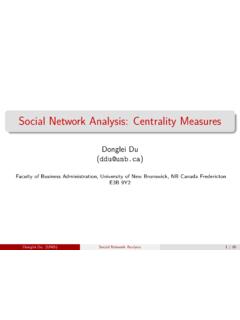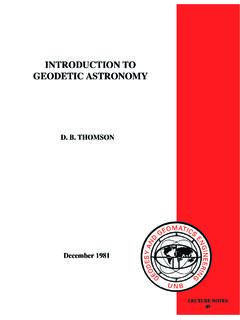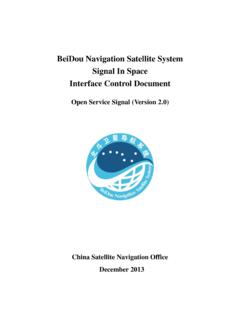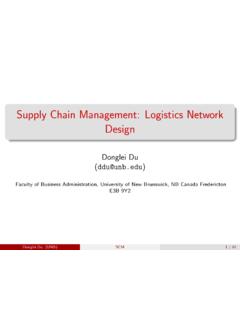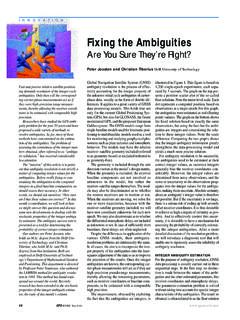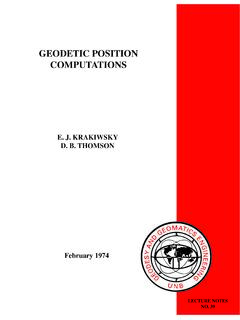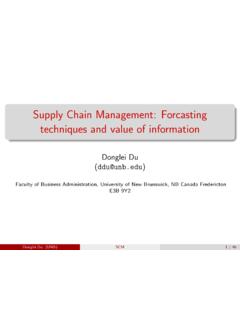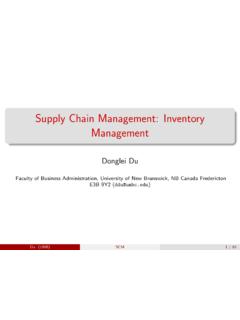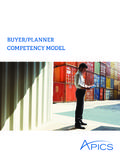Transcription of Supply Chain Management: Inventory Management
1 Supply Chain Management : InventoryManagementDonglei DuFaculty of Business Administration, University of New Brunswick, NB Canada FrederictonE3B 9Y2 (UNB)SCM1 / 83 Table of contents I1 Introduction2 Inventory Management3 Inventory models4 Economic Order Quantity (EOQ)EOQ modelWhen-to-order?5 Economic Production Quantity (EPQ): model descriptionEPQ model6 The Newsboy Problem-Unknown demand (probabilistic model)The newsvendor model7 Multiple-period stochastic model: model description8 Managing Inventory in the Supply chainDu (UNB)SCM2 / 83 Section 1 IntroductionDu (UNB)SCM3 / 83 Outline I1 Introduce some basic concepts in Inventory managementInventory level (IL)Reorder point (ROP)Lead timeSafety stockContinuous review and periodic review systemsService level2 Introduce some basic Inventory models, both deterministic models1 EOQ model2 EPQ modelprobabilistic models1 Single-period model: Newsboy model2 Multiple-period modelDu (UNB)SCM4 / 83 Section 2 Inventory ManagementDu (UNB)SCM5 / 83 What is Inventory ?
2 IInventoryis a stock or store of goods or services, kept for use orsale in the future. There are four types of inventoryRaw materials & purchased partsPartially completed goods called work in progress (WIP)Finished-goods inventoriesGoods-in-transit to warehouses or customers (GIT)The motive for Inventory : there are three motives for holdinginventory, similar to motive: Economies of scale is achieved when thenumber of set-ups are reduced or the number of transactionsare motive: hedge against uncertainty, includingdemand uncertainty, Supply uncertaintySpeculative motive: hedge against price increases in materials orlaborDu (UNB)SCM6 / 83 What is Inventory Management ?The objective of Inventory is to achieve satisfactory levels ofcustomer service while keeping Inventory costs within of customer service: (1) in-stock (fill) rate (2) number ofback orders (3) Inventory turnover rate: the ratio of average costof goods sold to average Inventory investmentInventory cost: cost of ordering and carrying trade-offDu (UNB)SCM7 / 83An Example ILet us look at a typical Supply Chain consists of suppliers andmanufacturers, who convert raw materials into finishedmaterials, and distribution centers and warehouses, form whichfinished products are distributed to customers.
3 This implies thatinventory appears in the Supply Chain in several forms:suppliersplantsdistributorswarehou sesretailerscustomersInventory & warehousing costsTransportationcostTransportationcos tTransportationcostRaw materialsWork-in-process (WIP)Finished productGoods-in-transit (GIP) Inventory & warehousing costsProduction/purchase costsDu (UNB)SCM8 / 83 Section 3 Inventory modelsDu (UNB)SCM9 / 83 Inventory Models IInventory models come in all shapes. We will focus on modelsfor only a single product at a single location. Essentially eachinventory model is determined by three key variables:demand:deterministic, that is, known exactly and in Forecasting technique may be used in the latter casewhen historical data are available to estimate the average andstandard deviation of the demand (will introduce forecastingtechniques later).costs:order cost: the cost of product and the transportation costinventory holding cost: taxes and insurances, maintenance, aspects of the system: the physical structure of theinventory system, such as single or , there are two basic decisions in all Inventory models:Du (UNB)SCM10 / 83 Inventory Models II1 How much to order?
4 2 When to order?Du (UNB)SCM11 / 83 Section 4 Economic Order Quantity (EOQ)Du (UNB)SCM12 / 83 Subsection 1 EOQ modelDu (UNB)SCM13 / 83 Economic Order Quantity (EOQ): Modeldescription IThe EOQ model is a simple deterministic model that illustratesthe trade-offs between ordering and Inventory a single warehouse facing constant demand for a singleitem. The warehouse orders from the supplier, who is assumedto have an unlimited quantity of the EOQ model assume the following scenario:Annual demandDis deterministic and occurs at a constantrate constant demand rate: , the same number of units istaken from Inventory each period of time, such as 5 units perday, 25 units per week, 100 units per month and so quantity are fixed atQunits per (UNB)SCM14 / 83 Economic Order Quantity (EOQ): Modeldescription IIA fixed ordering costcoper order, not depending on thequantity holding costchper unit per year, depending on the size ofthe Inventory . Sometimes holding cost can usually be calculatedas follows:ch=annual holding cost rate annual cost of holding one unit in Inventory =ICDu (UNB)SCM15 / 83 Shortages (such as stock-outs and backorder) are not is no lead time or the lead time is planning horizon is longThe objective is to decide the order quantityQper order so asto minimize the total annual cost, including holding andsetting-up (UNB)SCM16 / 83 Economic Order Quantity (EOQ): AnalysisThe following graph illustrates the Inventory level as a functionof time a saw-toothed Inventory on handQtimeplaceorderreceiveorderplaceorde rlead timereceiveorderDu (UNB)SCM17 / 83 Inventory level (IL)is the quantity on hand, which is differentfrominventory position (IP), which is equal to inventoryon-hand plus quantity on order minus backorder (if any).
5 The maximumILisQ, the minimum is 0, therefore the holding cost=Average Inventory Annual holding cost per unit=Q2chAnnual ordering cost=Number of orders per year cost per order=DQcoSoTotal annual cost=annual holding cost+annual setup cost=Q2ch+DQcoDu (UNB)SCM18 / 83 The trade-off of holding and ordering costs is illustrated in thefollowing Quantity (Q)The Total-Cost Curve is U-ShapedOrdering CostsQO Annual Cost(optimal order quantity)TCQHDQS=+2Du (UNB)SCM19 / 83 Therefore, the optimal order quantity is achieved at the pointwhere the two costs economic order quantity isQ = 2 Dcoch2 The cycle time (the time between two consecutive orders) isCycle Time=Q D3 Number of orders per yearNumber of orders per year=1cycle time=DQ Du (UNB)SCM20 / 83An Example IA local distributor for a national tire company expects to sellapproximately 9600 steel-belted radical tires of a certain size andtread design next year. Annual carrying cost is $16 per tire, andordering cost is $75 per order.
6 The distributor operates 288 daysa is the EOQ?Q = 2 Dco/ch= 2(9600)75/16 = 3002 How many times per year would the store reorder if the ECQ isordered?D/Q = 9600/300 = 32Du (UNB)SCM21 / 83An Example II3 What is the length of an order cycle if the EOQ is ordered?Q /D= 300/9600 = 1/32yearor1/32 288 = 9working days4 What is the total (Q /2)ch+(D/Q )co= (300/2)16+(9600/300)75 = 4800Du (UNB)SCM22 / 83 Sensitivity analysisEstimating ordering and Inventory costs is not an easy job, letalone accurate. Now let us see whether the EOQ model isrobust to the costs, , whether the order quantity is stable ornot when the costs claim isEOQ model is insensitiveto small variations orerrors in the cost (UNB)SCM23 / 83 Subsection 2 When-to-order?Du (UNB)SCM24 / 83 When-to-order: some conceptsThe reorder point (ROP) is defined to be the Inventory level atwhich a new order should be when-to-order decision is usually expressed in terms of areorder will consider deterministic and stochastic models (UNB)SCM25 / 83 When-to-order: deterministic demand anddeterministic lead timeHere we consider a simple deterministic demand anddeterministic lead time constant demand per period times is`for a new order in terms of `dNote that in our previous EOQ model, we assume`= 0so thereorder point isROP= (UNB)SCM26 / 83levelInventory Time timelead=lROP timelead=lddldDu (UNB)SCM27 / 83An Example IMr.
7 X takes two special tablets per day, which are delivered tohis home seven days after an order is called in. At what pointshould Mr. X reorder?Solution: In this case, the daily demand and lead time areboth constants (special random variable), andd= 2`= 7 ThereforeROP=`d= 2 7 = , Mr. X should reorder when there are 14 (UNB)SCM28 / 83 When-to-order: stochastic demand and stochasticlead timeThe reorder point for stochastic demand and stochastic leadtime is the expected demand during lead time and an extrasafety stock, which serves to reduce the probability ofexperiencing a stockout during lead time. FormallyROP=Expected demand during lead time+Safety stockDu (UNB)SCM29 / 83 Safety stock (SS): stock that is held in excess of expecteddemand due to variable demand rate and/or variable lead following figure illustrates how safety stock can reduce therisk of stockout during lead demandduring lead timeMaximum probable demandduring lead timeROPQ uantitySafety stockDu (UNB)SCM30 / 83 Service level (SL): the probability that demand will not exceedsupply during lead time ( , the probability of no stockout).
8 Sothe risk of stockout is1 ofa stockoutService levelProbability ofno stockoutExpecteddemandSafetystock0zQuant ityz-scaleDu (UNB)SCM31 / 83 AssumptionWe assume1 Daily demands are random variables;2 Daily demands are independent of the lead amount of safety stock depends on1 The desired service level1 .2 Daily demand random (rate) variableDifor dayi, and hencethe unit ofDiis items/per day suppose expectation andstandard deviation ofDiare( D, D).3 Lead time random variableL, and hence the unit ofLisnumber of days suppose expectation and standard deviationare( L, L).So thelead time demand demand during lead time, which is anew random variable with unit being number of items is equal toDL=L i=1Di=D1+ +DLDu (UNB)SCM32 / 83 Then, we use thecompound random variableproperty to findthe expectation and variance ofDL(note that here bothDi sandLare random variable and we cannot apply the rule ofexpectation and rule of variance directly):E[DL] =E[L i=1Di]= L DV[DL] =V[L i=1Di]= L 2D+ 2L 2 DAssumeDLfollows a normal distribution, that isDL N(E[DL], V[DL]).
9 Then ROP should be chosen such that the probability of nostockout is at least1 , that isP(DL ROP) 1 A standardgiven-p-value-find-x-valuecalcul ation gives us thedesired ROP:ROP=E[DL] +z V[DL] = D L+z L 2D+ 2D 2 LDu (UNB)SCM33 / 83An Example IA restaurant used an average of 50 jars of a special sauce eachweek. Weekly usage of sauce has a standard deviation of 3 manger is willing to accept no more than a 10 percent riskof stockout during lead time, which is two weeks. Assume thedistribution of usage is Normal. What is the ROP?Solution: In this case, the weekly demand is random and thelead time is constant, and = , D= 50, L= 2, D= 3, L= 0. ThereforeROP= D L+z L 2D+ 2D 2L= 2 50 + 2(3)2= , the ROP is approximately 106 (UNB)SCM34 / 83 Section 5 Economic Production Quantity (EPQ): modeldescriptionDu (UNB)SCM35 / 83 Subsection 1 EPQ modelDu (UNB)SCM36 / 83 Economic Production Quantity (EPQ): modeldescription IEconomic Production Quantity (EPQ), also called EconomicManufacturing Quantity (EMQ), is similar to EOQ model withone difference: instead of orders received in a single delivery,units are received incrementally during production, that is,constant production assumptions of the basic EPQ model are the following:Annual demandDis deterministic at a fixed rate productionPis deterministic at a fixed rate ofpunits/per day, wherep > setup costconow has a different meaning it is usually thecost to prepare for a production rum, which is independent ofthe production lot (UNB)SCM37 / 83 Economic Production Quantity (EPQ).
10 Modeldescription IIA holding costchper unit per year, depending on the size ofthe (such as stock-outs and backorder) are not is no lead time or the lead time is planning horizon is longDu (UNB)SCM38 / 83 The following simple observation will be used shortly, whichbasically a unit transformation: year or EPQ model is designed for production situations in which,once an order is placed, production begins and a constantnumber of units is produced to Inventory each day until theproduction run has been introduce the concept oflot size, which is the number ofunits in an order. In general, if we letQdenote the productionlot size, then the objective is to find the production lot size thatminimizes the total holding and ordering (UNB)SCM39 / 83 Economic Production Quantity (EPQ): analysisDuring the production run, there are two activities (see thefollowing figure):Demand reduces the inventoryProduction adds to the inventoryinventory leveltimeLot sizeQp-ddpProductionandusageusageonlyMax imumInventoryImaxpQAverage Inventory0Du (UNB)SCM40 / 83 Now we establish our total cost model analogously as , we consider the annual holding cost.
